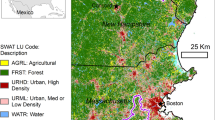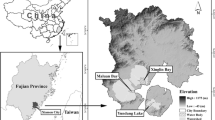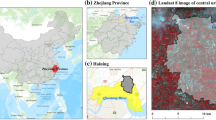Abstract
While most research about the relationship between land use and watershed hydrological output has focused primarily on land-use types and their impact on hydrological processes, the relationship between characteristics of land-use patterns (such as pattern fragmentation, connectivity, and coherence) and hydrological processes has not been well examined. Using historical stormwater data, this study evaluates the hydrological effects of different land-use scenarios in the Qing-shui watershed in Beijing, China, at a variety of spatial scales. This study demonstrates that planning and managing land-use patterns can significantly reduce runoff under different scales, particularly for small storm events. In contrast to other aspects of land-use structure characteristics, such as the shape complexity of land-use patches, fragmented level of the patches of land-use types appear as dominant drivers of runoff. The results of the study suggest that land-use pattern management should be an important component of Best Management Practices to reduce the impacts of urbanization on natural hydrological processes.


Similar content being viewed by others

References
Aguilera F, Valenzuela LM, Botequilha-Leitao A (2011) Landscape metrics in the analysis of urban land use patterns: a case study in a Spanish metropolitan area. Landsc Urban Plan 99(3–4):226–238
Andren H (1994) Effects of habitat fragmentation on birds and mammals in landscapes with different proportions of suitable habitat—a review. Oikos 71(3):355–366
Ansley RJ, Ben Wu X, Kramp BA (2001) Observation: long-term increases in mesquite canopy cover in a North Texas savanna. J Range Manag 54(2):171–176
Armenteras D, Gast F, Villareal H (2003) Andean forest fragmentation and the representativeness of protected natural areas in the eastern Andes, Colombia. Biol Conserv 113(2):245–256
Arnold CL, Gibbons CJ (1996) Impervious surface coverage—the emergence of a key environmental indicator. J Am Plan Assoc 62(2):243–258
Bogaart PW, Van Balen RT, Kasse C, Vandenberghe J (2003) Process-based modelling of fluvial system response to rapid climate change II. Application to the river Maas (the Netherlands) during the Last Glacial–Interglacial Transition. Quat Sci Rev 22(20):2097–2110
Booth DB, Karr JR, Schauman S et al (2004) Reviving urban streams: land use, hydrology, biology, and human behavior. J Am Water Resour Assoc 40(5):1351–1364
Brennan SP, Schnell GD (2005) Relationship between bird abundances and landscape characteristics: the influence of scale. Environ Monit Assess 105(1–3):209–228
Breuer L, Huisman JA, Frede HG (2006) Monte Carlo assessment of uncertainty in the simulated hydrological response to land use change. Environ Model Assess 11(3):209–218
Bronstert A, Niehoff D, Burger G (2002) Effects of climate and land-use change on storm runoff generation: present knowledge and modelling capabilities. Hydrol Process 16(2):509–529
Buyantuyev A, Wu JG, Gries C (2010) Multiscale analysis of the urbanization pattern of the Phoenix metropolitan landscape of USA: time, space and thematic resolution. Landsc Urban Plan 94(3–4):206–217
Calder IR, Reid I, Nisbet TR, Green JC (2003) Impact of lowland forests in England on water resources: application of the Hydrological Land Use Change (HYLUC) model. Water Resour Res 39(11):1319
Camorani G, Castellarin A, Brath A (2005) Effects of land-use changes on the hydrologic response of reclamation systems. Phys Chem Earth 30(8–10):561–574
Carle MV, Halpin PN, Stow CA (2005) Patterns of watershed urbanization and impacts on water quality. J Am Water Resour Assoc 41(3):693–708
Carlson TN, Arthur ST (2000) The impact of land use—land cover changes due to urbanization on surface microclimate and hydrology: a satellite perspective. Glob Planet Change 25(1–2):49–65
Carter T, Jackson CR (2007) Vegetated roofs for stormwater management at multiple spatial scales. Landsc Urban Plan 80(1–2):84–94
Chen Y, Xu YP, Yin YX (2009) Impacts of land use change scenarios on storm-runoff generation in Xitiaoxi basin, China. Quat Int 208:121–128
Collinge SK (1996) Ecological consequences of habitat fragmentation: implications for landscape architecture and planning. Landsc Urban Plan 36(1):59–77
Coppedge BR, Engle DM, Fuhlendorf SD, Masters RE, Gregory MS (2001) Landscape cover type and pattern dynamics in fragmented southern Great Plains grasslands, USA. Landsc Ecol 16(8):677–690
Cumming GS, Cumming DHM, Redman CL (2006) Scale mismatches in social–ecological systems: causes, consequences, and solutions. Ecol Soc 11(1):14
Dauer DM, Ranasinghe JA, Weisberg SB (2000) Relationships between benthic community condition, water quality, sediment quality, nutrient loads, and land use patterns in Chesapeake Bay. Estuaries 23(1):80–96
DeFries R, Eshleman NK (2004) Land-use change and hydrologic processes: a major focus for the future. Hydrol Process 18(11):2183–2186
DeFries R, Hansen A, Turner BL, Reid R, Liu JG (2007) Land use change around protected areas: management to balance human needs and ecological function. Ecol Appl 17(4):1031–1038
Deutsch CV, Journel AG (1992) GSLIB: geostatistical software library and user’s guide. Oxford University Press, Oxford
Downer CW, Ogden FL (2003) Prediction of runoff and soil moistures at the watershed scale: effects of model complexity and parameter assignment. Water Resour Res 39(3):1045
Downer CW, Ogden FL (2004) GSSHA: model to simulate diverse stream flow producing processes. J Hydrol Eng 9(3):161–174
Downer CW, Ogden FL (2006) Gridded surface subsurface hydrologic analysis (GSSHA) user’s manual. ERDC/CHL SR-06-1, United States Army Corps of Engineers, Engineering Research and Development Center, Vicksburg
Edwards AMC (1983) Stormwater management in urbanizing areas—Whipple, W, Grigg, NS, Grizzard, T, Randall, CW, Shubinski, RP, Tucker, LS. Water Res 17(10):1471
Fohrer N, Haverkamp S, Frede HG (2005) Assessment of the effects of land use patterns on hydrologic landscape functions: development of sustainable land use concepts for low mountain range areas. Hydrol Process 19(3):659–672
Forman RTT (1995) Land mosaic: the ecology of landscape and regions. Cambridge University Press, New York
Fu BJ, Wang J, Chen LD, Qiu Y (2003) The effects of land use on soil moisture variation in the Danangou catchment of the Loess Plateau, China. Catena 54(1–2):197–213
Gardner RH, Urban DL (2007) Neutral models for testing landscape hypotheses. Landsc Ecol 22(1):15–29
Gardner RH, Milne BT, Turner MG, O’Neill RV (1987) Neutral models for the analysis of broad-scale landscape pattern. Landsc Ecol 1(1):19–28
Gotway CA, Rutherford BM (1996) The components of geostatistical simulation. In: Mowrer HT, Czaplewski RL, Hamce RH (eds) Proceedings of the spatial accuracy assessment in natural resources and environmental sciences (second international symposium). US Department of Agriculture, Fort Collins, p 30–38
Gotway CA, Ferguson RB, Hergert GW, Peterson TA (1996) Comparison of kriging and inverse-distance methods for mapping soil parameters. Soil Sci Soc Am J 60(4):1237–1247
He HS, DeZonia BE, Mladenoff DJ (2000) An aggregation index (AI) to quantify spatial patterns of landscapes. Landsc Ecol 15(7):591–601
Hejazi MI, Markus M (2009) Impacts of urbanization and climate variability on floods in Northeastern Illinois. J Hydrol Eng 14(6):606–616
Herold M, Scepan J, Clarke KC (2002) The use of remote sensing and landscape metrics to describe structures and changes in urban land uses. Environ Plan A 34(8):1443–1458
Herzog F, Lausch A, Muller E, Thulke HH, Steinhardt U, Lehmann S (2001) Landscape metrics for assessment of landscape destruction and rehabilitation. Environ Manag 27(1):91–107
Huang HJ, Cheng SJ, Wen JC, Lee JH (2008) Effect of growing watershed imperviousness on hydrograph parameters and peak discharge. Hydrol Process 22(13):2075–2085
Hundecha Y, Bardossy A (2004) Modeling of the effect of land use changes on the runoff generation of a river basin through parameter regionalization of a watershed model. J Hydrol 292(1–4):281–295
Jang S, Cho M, Yoon J et al (2007) Using SWMM as a tool for hydrologic impact assessment. Desalination 212(1–3):344–356
Joyce BA, Wallender WW, Angermann T et al (2004) Using infiltration enhancement and soil water management to reduce diazinon in runoff. J Am Water Resour Assoc 40(4):1063–1070
Kabir MA, Dutta D, Hironaka S (2011) Process-based distributed modeling approach for analysis of sediment dynamics in a river basin. Hydrol Earth Syst Sci 15(4):1307–1321
Karlaviciene V, Svediene S, Marciulioniene DE, Randerson P, Rimeika M, Hogland W (2009) The impact of storm water runoff on a small urban stream. J Soil Sediment 9(1):6–12
Kondoh A, Nishiyama J (2000) Changes in hydrological cycle due to urbanization in the suburb of Tokyo Metropolitan Area, Japan. Adv Space Res 26(7):1173–1176
Kosmas C, Danalatos N, Cammeraat LH et al (1997) The effect of land use on runoff and soil erosion rates under Mediterranean conditions. Catena 29(1):45–59
Lammert M, Allan JD (1999) Assessing biotic integrity of streams: effects of scale in measuring the influence of land use/cover and habitat structure on fish and macroinvertebrates. Environ Manag 23(2):257–270
Lau SL, Khan E, Stenstrom MK (2001) Catch basin inserts to reduce pollution from stormwater. Water Sci Technol 44(7):23–34
Lee JG, Heaney JP (2003) Estimation of urban imperviousness and its impacts on storm water systems. J Water Resour Plan Manag 129(5):419–426
Lee SW, Hwang SJ, Lee SB, Hwang HS, Sung HC (2009) Landscape ecological approach to the relationships of land use patterns in watersheds to water quality characteristics. Landsc Urban Plan 92(2):80–89
Legesse D, Vallet-Coulomb C, Gasse F (2003) Hydrological response of a catchment to climate and land use changes in Tropical Africa: case study South Central Ethiopia. J Hydrol 275(1–2):67–85
Li HB, Wu JG (2004) Use and misuse of landscape indices. Landsc Ecol 19(4):389–399
Li XZ, He HS, Wang XG, Bu RC, Hu YM, Chang Y (2004) Evaluating the effectiveness of neutral landscape models to represent a real landscape. Landsc Urban Plan 69(1):137–148
Lin YP, Hong NM, Wu PJ, Wu CF, Verburg PH (2007) Impacts of land use change scenarios on hydrology and land use patterns in the Wu-Tu watershed in Northern Taiwan. Landsc Urban Plan 80(1–2):111–126
Lin YP, Verburg PH, Chang CR, Chen HY, Chen MH (2009) Developing and comparing optimal and empirical land-use models for the development of an urbanized watershed forest in Taiwan. Landsc Urban Plan 92(3–4):242–254
Linke J, McDermid GJ, Pape AD et al (2009) The influence of patch-delineation mismatches on multi-temporal landscape pattern analysis. Landsc Ecol 24(2):157–170
Lorup JK, Refsgaard JC, Mazvimavi D (1998) Assessing the effect of land use change on catchment runoff by combined use of statistical tests and hydrological modelling: case studies from Zimbabwe. J Hydrol 205(3–4):147–163
Luck M, Wu JG (2002) A gradient analysis of urban landscape pattern: a case study from the Phoenix metropolitan region, Arizona, USA. Landsc Ecol 17(4):327–339
Mccoll C, Aggett G (2007) Land-use forecasting and hydrologic model integration for improved land-use decision support. J Environ Manag 84(4):494–512
Mccuen RH (1979) Stormwater management policy and design. J Civil Eng Des 1(1):21–42
Mccuen RH (1989) Hydrologic analysis and design. Prentice Hall, Englewood Cliffs
McGarigal K, Marks BJ (1995) FRAGSTATS: spatial pattern analysis program for quantifying landscape structure. General Technical Report PNW-GTR-351
Mendoza M, Bocco G, Bravo M (2002) Spatial prediction in hydrology: status and implications in the estimation of hydrological processes for applied research. Prog Phys Geogr 26(3):319–338
Miltner RJ, White D, Yoder C (2004) The biotic integrity of streams in urban and suburbanizing landscapes. Landsc Urban Plan 69(1):87–100
Moiwo JP, Lu WX, Zhao YS, Yang YH, Yang YM (2010) Impact of land use on distributed hydrological processes in the semi-arid wetland ecosystem of Western Jilin. Hydrol Process 24(4):492–503
Moloney KA, Levin SA (1996) The effects of disturbance architecture on landscape-level population dynamics. Ecology 77(2):375–394
Nagasaka A, Nakamura F (1999) The influences of land-use changes on hydrology and riparian environment in a northern Japanese landscape. Landsc Ecol 14(6):543–556
Niehoff D, Fritsch U, Bronstert A (2002) Land-use impacts on storm-runoff generation: scenarios of land-use change and simulation of hydrological response in a meso-scale catchment in SW-Germany. J Hydrol 267(1–2):80–93
O’neill RV, Gardner RH, Turner MG (1992) A hierarchical neutral model for landscape analysis. Landsc Ecol 7(1):55–61
O’Neill RV, Hunsaker CT, Timmins SP et al (1996) Scale problems in reporting landscape pattern at the regional scale. Landsc Ecol 11(3):169–180
Olang LO, Furst J (2011) Effects of land cover change on flood peak discharges and runoff volumes: model estimates for the Nyando River Basin, Kenya. Hydrol Process 25(1):80–89
Ott B, Uhlenbrook S (2004) Quantifying the impact of land-use changes at the event and seasonal time scale using a process-oriented catchment model. Hydrol Earth Syst Sci 8(1):62–78
Paudel M, Nelson EJ, Downer CW, Hotchkiss R (2011) Comparing the capability of distributed and lumped hydrologic models for analyzing the effects of land use change. J Hydroinform 13(3):461–473
Peters DPC, Bestelmeyer BT, Turner MG (2007) Cross-scale interactions and changing pattern–process relationships: consequences for system dynamics. Ecosystems 10(5):790–796
Rawls WJ, Brakensiek DL, Miller N (1983) Green-Ampt infiltration parameters from soils data. J Hydraul Eng 109(1):62–70
Rose S, Peters NE (2001) Effects of urbanization on streamflow in the Atlanta area (Georgia, USA): a comparative hydrological approach. Hydrol Process 15(8):1441–1457
Roy AH, Freeman MC, Freeman BJ, Wenger SJ, Ensign WE, Meyer JL (2005) Investigating hydrologic alteration as a mechanism of fish assemblage shifts in urbanizing streams. J North Am Benthol Soc 24(3):656–678
Saura S, Martinez-Millan J (2000) Landscape patterns simulation with a modified random clusters method. Landsc Ecol 15(7):661–678
Schiff R, Benoit G (2007) Effects of impervious cover at multiple spatial scales on coastal watershed streams. J Am Water Resour Assoc 43(3):712–730
Schroder B (2006) Pattern, process, and function in landscape ecology and catchment hydrology—how can quantitative landscape ecology support predictions in ungauged basins? Hydrol Earth Syst Sci 10(6):967–979
Schroder B, Seppelt R (2006) Analysis of pattern–process interactions based on landscape models—overview, general concepts, and methodological issues. Ecol Model 199(4):505–516
Seto KC, Fragkias M (2005) Quantifying spatiotemporal patterns of urban land-use change in four cities of China with time series landscape metrics. Landsc Ecol 20(7):871–888
Shao GF, Wu JG (2008) On the accuracy of landscape pattern analysis using remote sensing data. Landsc Ecol 23(5):505–511
Sharif HO, Sparks L, Hassan AA, Zeitler J, Xie HJ (2010) Application of a distributed hydrologic model to the November 17, 2004, Flood of Bull Creek Watershed, Austin, Texas. J Hydrol Eng 15(8):651–657
Shuster WD, Zhang Y, Bonta J, Thurston H, Warnemuende E (2004) Comprehensive research and impacts of management of imperviousness on watershed hydrology. In: Land and water management: decision tools and practices, vols 1–2, p 527–535
Tischendorf L (2001) Can landscape indices predict ecological processes consistently? Landsc Ecol 16(3):235–254
Trombulak SC, Frissell CA (2000) Review of ecological effects of roads on terrestrial and aquatic communities. Conserv Biol 14(1):18–30
Tscharntke T, Steffan-Dewenter I, Kruess A, Thies C (2002) Contribution of small habitat fragments to conservation of insect communities of grassland–cropland landscapes. Ecol Appl 12(2):354–363
Turner MG (1989) Landscape ecology—the effect of pattern on process. Annu Rev Ecol Syst 20:171–197
Turner IM (1996) Species loss in fragments of tropical rain forest: a review of the evidence. J Appl Ecol 33(2):200–209
Turner MG, O’Neill RV, Gardner RH, Milne BT (1989) Effects of changing spatial scale on the analysis of landscape pattern. Landsc Ecol 3(3–4):153–162
Turner MG, Wu YG, Romme WH, Wallace LL (1993) A landscape simulation-model of winter foraging by large ungulates. Ecol Model 69(3–4):163–184
Urbonas B (1993) 3-City stormwater permit application process in Denver USA. In: Proceedings of the sixth international conference on urban storm drainage, vols 1–2, p 1964–1969
Uuemaa E, Roosaare J, Mander U (2005) Scale dependence of landscape metrics and their indicatory value for nutrient and organic matter losses from catchments. Ecol Indic 5(4):350–369
Uuemaa E, Roosaare J, Mander U (2007) Landscape metrics as indicators of river water quality at catchment scale. Nord Hydrol 38(2):125–138
Viney NR, Sivapalan M (2001) Modelling catchment processes in the Swan-Avon river basin. Hydrol Process 15(13):2671–2685
Wang LZ, Lyons J, Kanehl P (2001) Impacts of urbanization on stream habitat and fish across multiple spatial scales. Environ Manag 28(2):255–266
With KA, King AW (1997) The use and misuse of neutral landscape models in ecology. Oikos 79(2):219–229
Wu JG (2004) Effects of changing scale on landscape pattern analysis: scaling relations. Landsc Ecol 19(2):125–138
Wu JG, Shen WJ, Sun WZ, Tueller PT (2002) Empirical patterns of the effects of changing scale on landscape metrics. Landsc Ecol 17(8):761–782
Xiang WN (1996) GIS-based riparian buffer analysis: injecting geographic information into landscape planning. Landsc Urban Plan 34(1):1–10
Xiao HG, Ji W (2007) Relating landscape characteristics to non-point source pollution in mine waste-located watersheds using geospatial techniques. J Environ Manag 82(1):111–119
Yang DW, Kanae S, Oki T, Koike T, Musiake K (2003) Global potential soil erosion with reference to land use and climate changes. Hydrol Process 17(14):2913–2928
Yilmaz KK, Gupta HV, Wagener T (2008) A process-based diagnostic approach to model evaluation: application to the NWS distributed hydrologic model. Water Resour Res 44(9):W09417
Yusop Z, Chan CH, Katimon A (2007) Runoff characteristics and application of HEC-HMS for modelling stormflow hydrograph in an oil palm catchment. Water Sci Technol 56(8):41–48
Zhang SH, PENG GB (2004) The feature extraction and data fusion of regional soil textures based on GIS techniques. Clim Environ Res 9(1):65–79
Zhang LQ, Wang HZ (2006) Planning an ecological network of Xiamen Island (China) using landscape metrics and network analysis. Landsc Urban Plan 78(4):449–456
Zhang LQ, Wu JP, Zhen Y, Shu H (2004) A GIS-based gradient analysis of urban landscape pattern of Shanghai metropolitan area, China. Landsc Urban Plan 69(1):1–16
Zhao M, Liu X, Zheng BF, Zhao JZ (2008) Landscape pattern analysis and management research in the Lugu Lake area. Int J Sustain Dev World Ecol 15(1):36–41
Zhou YY, Wang YQ, Gold AJ, August PV (2010) Modeling watershed rainfall–runoff relations using impervious surface-area data with high spatial resolution. Hydrogeol J 18(6):1413–1423
Acknowledgements
This study is financially supported by National Natural Science Foundation of China (40671117). The authors also thank to four anonymous reviewers for insightful and constructive comments.
Author information
Authors and Affiliations
Corresponding author
Rights and permissions
About this article
Cite this article
Zhang, G., Guhathakurta, S., Dai, G. et al. The Control of Land-Use Patterns for Stormwater Management at Multiple Spatial Scales. Environmental Management 51, 555–570 (2013). https://doi.org/10.1007/s00267-012-0004-6
Received:
Accepted:
Published:
Issue Date:
DOI: https://doi.org/10.1007/s00267-012-0004-6



